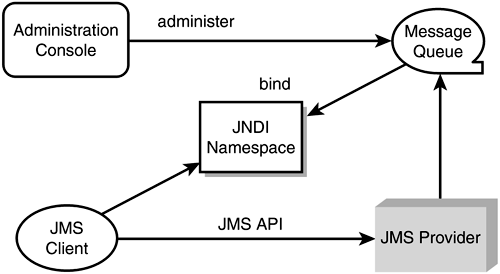JMS API Architecture
The working model of a JMS messaging system, shown in Figure 15.3, consists of these parts:
A client that creates the message
A destination, also known as the queue or topic
Messages to be passed between the sender and receiver
Destinations (that is, queues and topics) and connection factories, also known as administered objects, which are configured by the administrator for use by the client
The JMS provider, which provides the JMS features, including a JNDI namespace and administrative tools
Figure 15.3. JMS API architecture.

A message, as defined earlier, has header fields, properties, and a body. Figure 15.4 illustrates the ...
Get Sams Teach Yourself BEA WebLogic Server 7.0™ in 21 Days now with the O’Reilly learning platform.
O’Reilly members experience books, live events, courses curated by job role, and more from O’Reilly and nearly 200 top publishers.

